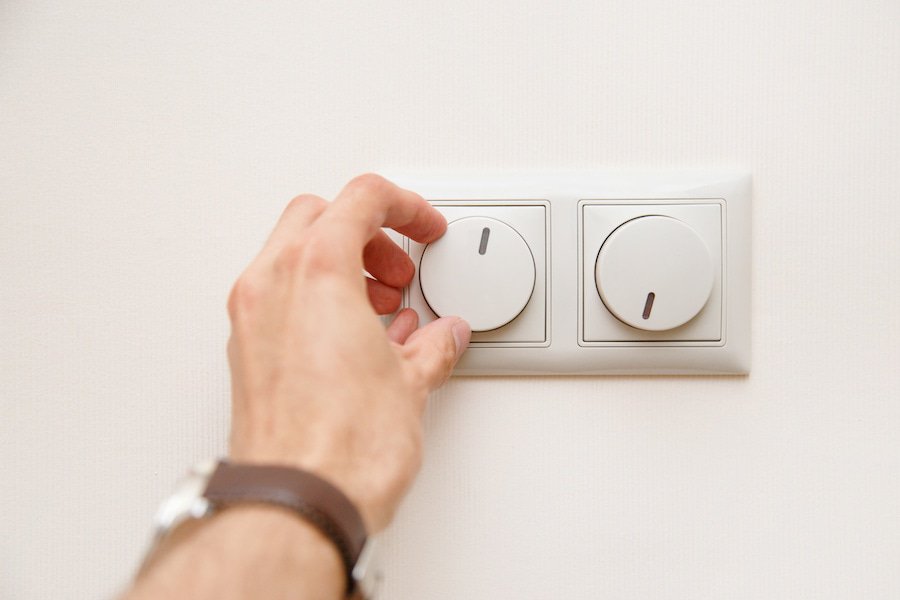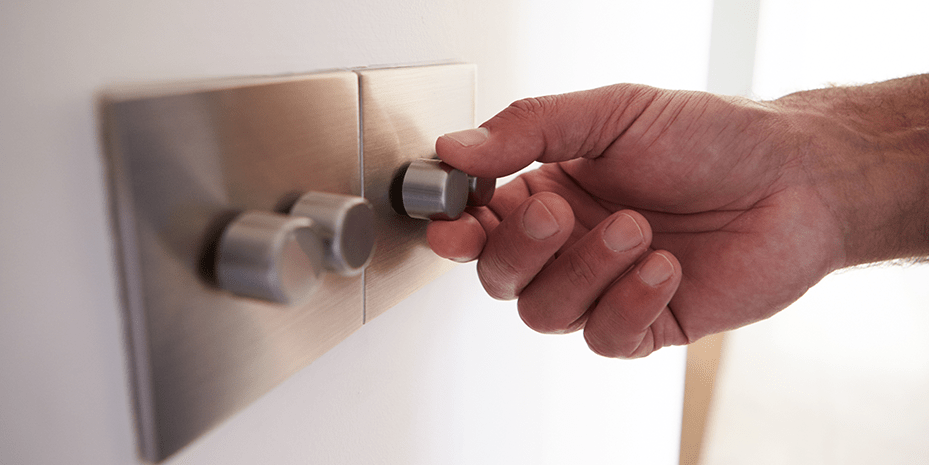A dimmer is an electrical switch used to vary the voltage supplied to a device or group of devices such as lamps, independent lighting circuits, etc.
How does it work?
Dimmers can come in different forms and configurations but essentially how they all work is by altering the overall brightness of a light bulb(s) by limiting the amount of current that flows through its system. This ensures that the lamp operates at its most efficient point for longer periods of time which saves energy and money.
The dimming process employs what we call PWM (Pulse-Width Modulation). The switch alternates between supplying full power and no power at all to an electronic load such as a led light strip at very high speed (15 000 times per second). A light-emitting diode (led) is essentially just a diode that emits visible light when electricity passes through it.
The intensity of the emitted light is proportional to the frequency rate at which the power is switched on and off. When this happens with an led strip, that's what gives it its brightness (the higher the frequency rate = brighter).
When you dim your lights, depending on how old your dimmer switch is, chances are they might be flickering or giving you problems in terms of dimming down very slowly. This usually means there's too much resistance between the different wires attached to each end of it. Replacing it is easier than one might think provided you follow basic steps like I'm about to tell you below.
Dimming capacity
Dimmer switches come with different levels of dimming capacity and some might not be compatible with led lights. If you're not sure what type of dimmer switch you have, it's best to consult the manufacturer or take it to an electrician to find out.

Its construction
Your dimmer switch has three terminals on both sides: L: power coming in R: power going out (enough wattage to connect one side of your led strip) W: wire that connects to the other end of your led strip When you open up your dimmer, you'll see a bunch of metallic components on each side.
The left and right ones are the common connections for neutral and hot wires respectively. There's also a black square component between these two smaller terminals which is what the actual electrical contact occurs on, this will either be physical or non-physical (represented as a square groove).
You need to make sure that this part is clean and free of corrosion. Also, check if it's loose and can move back and forth. If it can, you'll need to reattach it by soldering or using some strong adhesive.
Dimmer types
Nowadays, you have two types of dimmers to choose from: physical and digital.
A physical dimmer is a type of switch that mechanically slides up and down to adjust the amount of current passing through it. A digital dimmer on the other hand is controlled by a microprocessor that sends instructions to a triac (a three-terminal semiconductor device) that then switches the load on and off.
Pulse Width Modulation dimmers (PWM)
The more you dim your lights, the dimmer they become (the led strip's output gets less bright). This is because of how a PWM dimmer works; it basically controls the current flow through the system by switching between full power and no power on and off at an extremely high rate.
So when you dial down your light switch to 0%, there's still some current flowing through the load (led strip), however, it's not enough to keep it lit up at its usual intensity.
Constant Current Reduction dimmers (CCR)
CCR dimmers are a newer technology that's specially designed to work with led lights. They work by providing a constant current (usually 350mA) to the strip which eliminates any flicker or brightness fluctuations.
Also here is another classification of dimmers:
- Resistive: The simplest and oldest type of dimmer switch is made up of a resistive strip (a material that resists electricity passing through it). As mentioned earlier, this does not work well with led lights. You can use this for incandescent or halogen lamps only. This is the cheapest option but also one of the most inefficient as power gets wasted when it encounters resistance.
- High wattage: High wattage dimmers are better than the others because they minimize loss to heat by means of allowing much higher currents to be carried through them. They tend to last longer and waste less energy compared to other types of dimmer switches which burn out easily and aren't as durable as high-wattage ones.
- Magnetic: Magnetic dimmer switches are usually used for low voltage halogen lighting applications. They use a mercury arc rectifier to control voltage and current to the load which results in full power being applied at all times with no fluctuations. They can safely control up to 50 amperes of electric current and also come as two-wire or three-wire circuits depending on where they're going to be installed.
- Electronic: This is a common type of switch being used today especially with led lights because it can handle high currents and works well with lower wattage devices such as led strip lights. It uses transistorized circuitry so there's no flickering or humming noise when dimming down unlike the older types of dimmers mentioned earlier.
- Touch: As the name suggests, a touch dimmer switch allows for light control by touch. It's a great option for people with mobility issues or who just want an easy way to dim their lights. All you have to do is touch the top of the switch and it will give you immediate light control.

Which one should I get?
This really depends on your needs but in general, if you're looking for a more permanent installation or have larger lights, then go with a physical dimmer. If you're wanting something more portable or have smaller lights, then a digital one might be better suited for you.
When should you use a dimmer?
You should consider using a dimmer if you have lights that are normally on 100% of the time or for specific mood lighting.
Do you need special LED lights for dimming?
There are dimmable and non-dimmable lights. Non-dimmable led lights are less expensive but they do not dim super well. They usually emit a warm/yellowish light that will not put out the same quality of tone or color as when you have non-dimmable bulbs.
Dimmability is important to take into consideration if you bought a led strip and intend to use it for decoration purposes such as underneath your kitchen cabinets (this is very popular nowadays especially because of how easy they are to install).
So, you have to keep it in mind, cause you do need special LED lights for dimming in order for the process to take place.
Why use LED strip lights?
LED strip lights are easy to install, very energy efficient, and can be controlled by a remote, controller, or smartphone. They're affordable, offer great benefits compared to other types of light sources plus they're versatile as well since they come in many different colors, sizes, and styles.
How to install a dimmer
- Turn off the breaker that supplies power to the light fixture(s) you are going to dim.
- Remove the old switch and disconnect all the wires.
- If your new dimmer doesn't come with a ground wire, then you'll need to connect one (green or bare copper). Strip about ¾ of an inch of insulation from each end of the wire and twist them together. Then screw a green wire connector onto each end.
- Connect the black wire coming in from the wall to the black wire on your dimmer using a black wire connector.
- Connect the white wire coming in from the wall to the white wire on your dimmer using a blue wire connector. If your new switch does not have a ground wire, you can connect the ground wire of the light fixture directly to any bare metal screw on the electrical box by twisting it together with a short length of bare copper wire or using electrical tape to insulate it.
- Now that all wires are connected, take both sides apart and turn them around. Take note of how they were oriented before (usually there are indicators pointing towards where one terminal ends and others begin).
- Reattach them to each other but this time make sure that only every alternate metallic component is touching each other (elements like these do not conduct electricity):
-L to R (metal tab on L to metal tab on R)
-W to R (metal tab on W to metal tab on R)
-L to W (non-conductive material between L and W, do not attach) - Once they're all in place, close the switch and give it a test by turning the breaker back on. If it doesn't work, reattach everything and try again. Remember that if it still doesn't work, you might have connected something wrong or there's a short in the system. Contact an electrician if you're not comfortable doing this yourself.

How to replace your dimmer switch
Replacing your old, worn-out dimmer switch is actually pretty easy and can be done in just a few minutes. The steps we are about to list are for a physical dimmer but the same principle applies to digital ones too. So, here they are:
- Shut off the power to the switch at the breaker panel
- Remove the cover plate from the wall
- Disconnect the wires from the old dimmer (L, R, W)
- Connect the wires to your new dimmer in the same order: L, R, W
- Put everything back together and turn on the power
Testing your work
Once you've replaced your dimmer, it's always a good idea to test it out before putting everything back together. To do this, just turn on the light switch and dial it down to 0%. If everything is working properly, you should see that your led strip is now getting dim. Congratulations, you've successfully installed your dimmer switch!
Will a dimmer help you to reduce electricity consumption?
It's a good idea to use a dimmer if you're going to keep your led strip on for an extended period of time. The reason why is because it will make the lights look less harsh and it'll be easier on your eyes. However, because led lights are not as bright as incandescent ones, a dimmer won't really affect your electricity bill in any way.
Is it safe for children?
If you have children at home, then it's always a good idea to keep them away from less ones (especially dimmable), as they might burn themselves by touching the strip. However, if your child is old enough to understand how to use light switches and will not play with the lights when no one's watching, then you should be fine. Keep in mind that there are special strips that can only be dimmed using a special remote control or a smartphone app.
Conclusion
Dimmer switches are really simple to install and will make your led lights look more like natural ones.
If you're concerned about the safety of your family, then it's better if you go for a digital dimmer that can only be switched on using specific devices. If that's not possible, then just keep your children away from less switch whenever possible. However, as long as they know how to use light switches properly, there shouldn't be any problems at all.
And finally, if you want to save electricity costs but still have a dimmable lighting system in your home or office, consider buying a special strip with sensors that allow it to automatically fade every time the ambient brightness changes. Thank you for reading our article.